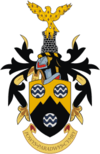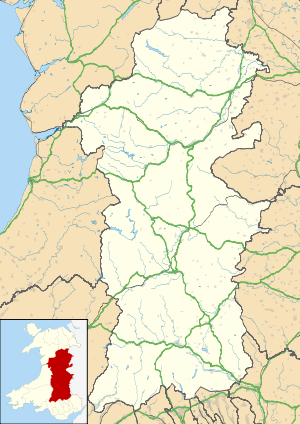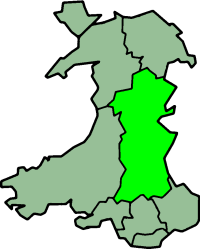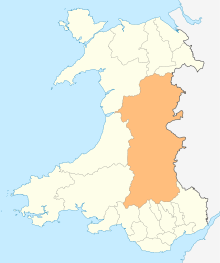Powys
Powys (/ˈpoʊɪs, ˈpaʊɪs/; Welsh: [ˈpowɪs])[1] is a principal area and county, and one of the preserved counties of Wales. It is named after the Kingdom of Powys which was a Welsh successor state, petty kingdom and principality that emerged during the Middle Ages following the end of Roman rule in Britain.
- See the List of places in Powys for all towns and villages in Powys.
County of Powys Sir Powys | |
|---|---|
 Coat of arms | |
 | |
| Sovereign state | |
| Country | |
| Preserved county | Powys |
| Established | 1 April 1996 |
| Admin HQ | County Hall, Llandrindod Wells |
| Largest town | Newtown, Powys |
| Government | |
| • Type | |
| • Control | Independent |
| • MPs | |
| • AMs |
|
| Area | |
| • Total | 5,200 km2 (2,000 sq mi) |
| Area rank | Ranked 1st |
| Population (2017) | |
| • Total | 132,447 |
| • Rank | Ranked 11th |
| • Density | 26/km2 (70/sq mi) |
| • Density rank | Ranked 22nd |
| • Ethnicity | 99.3% White |
| Welsh language | |
| • Rank | Ranked 7th |
| • Any skills | 30.1% |
| Geocode | 00NN (ONS) W06000023 (GSS) |
| ISO 3166 code | GB-POW |
Location
Powys covers the historic counties of Montgomeryshire and Radnorshire, most of Brecknockshire (Breconshire), and a small part of Denbighshire. With an area of about 2,000 square miles (5,200 km2), it is the largest unitary authority in Wales by land area and about the same size as the country of Trinidad and Tobago. It is bounded to the north by Gwynedd, Denbighshire and Wrexham; to the west by Ceredigion and Carmarthenshire; to the east by Shropshire and Herefordshire; and to the south by Rhondda Cynon Taf, Merthyr Tydfil, Caerphilly, Blaenau Gwent, Monmouthshire and Neath Port Talbot.
Human geography
The largest towns are Newtown, Ystradgynlais, Brecon, and Welshpool with populations in 2011 of 11,357, 8,092, 8,250 and 6,664 respectively. Powys has the lowest population density of all the principal areas of Wales. Most of Powys is mountainous and so north–south travel is difficult.
Just under a third of the residents have Welsh linguistic skills: Welsh speakers are concentrated mainly in the rural areas both in and around Machynlleth, Llanfyllin and Llanrhaeadr-ym-Mochnant (where William Morgan first translated the whole Bible into Welsh in 1588) in Montgomeryshire (Welsh: Sir Drefaldwyn), and the industrial area of Ystradgynlais in the southwest of Brecknockshire (Welsh: Sir Frycheiniog). Radnorshire (Welsh: Sir Faesyfed) was almost completely Anglicised by the end of the 18th century. The 2001 census records show 21% of the population of Powys were able to speak Welsh at that time, the same as for the whole of Wales.[2]
History
The county is named after the ancient Welsh Kingdom of Powys, which in the sixth century AD included the northern two-thirds of the area as well as most of Shropshire and adjacent areas now in England, and came to an end when it was occupied by Llywelyn ap Gruffudd of Gwynedd during the 1260s.
The uplands retain evidence of occupation from long before the Kingdom of Powys, and before the Romans, who built roads and forts across the area. There are 1130 identified burial mounds within the county, of varying styles and ages, dating from 4000BC to 1000BC, most of them belonging to the Bronze Age.[3] Of these, 339 are Scheduled Monuments. Standing stones, most again dating to the Bronze Age, also occur in large numbers, 276 being found across the county, of which 92 are scheduled. From the Iron Age, the county has 90 scheduled Hill forts and a further 54 enclosures and settlement sites.
Heraldry

The gold in the county coat of arms symbolises the wealth of the area. Black is for both mining and the Black Mountains. The fountain is a medieval heraldic charge displayed as a roundel barry wavy Argent and Azure. It represents water and refers to both the water catchment area and the rivers and lakes. Thus, the arms contain references to the hills and mountains, rivers and lakes, water supply and industry. The crest continues the colouring of the arms. A tower has been used in preference to a mural crown, which alludes to the county's military history and remains. From the tower rises a red kite, a bird almost extinct elsewhere in Britain but thriving in Powys. The bird is a "semé of black lozenges" for the former coal mining industry while the golden fleece it carries is a reference to the importance of sheep rearing in the county.[4]
The county motto is: Powys – the paradise of Wales (Welsh: Powys Paradwys Cymru).
Government
On 1 April 1974, Powys was created under the Local Government Act 1972 and originally had Montgomery and Radnor and Brecknock as districts within it, which were based directly on the former administrative counties. On 1 April 1996, the districts were abolished, and Powys was reconstituted as a unitary authority with a minor border adjustment in the northeast—specifically, the addition of the communities of Llansilin and Llangedwyn from Glyndwr district in Clwyd—and with moving the border, so that rather than half of Llanrhaeadr-ym-Mochnant, all is included.
The first Lord Lieutenant of Powys was previously the Lord Lieutenant of Montgomeryshire. The Lord Lieutenant of Brecknockshire and Lord Lieutenant of Radnorshire were appointed as Lieutenants. The present Lord Lieutenant is The Hon. Mrs Elizabeth Shân Legge-Bourke LVO of Crickhowell.
Attractions
CastlesLakes, reservoirs and waterfalls
Cave systems
|
Museums and exhibitions
Walks
Railways
|
Fairtrade
In December 2007, Powys was awarded Fairtrade County status by the Fairtrade Foundation.[8]
See also
References
- POH-iss with the vowels of "goat" and "kit" or POW-iss, with the vowels of "mouth" and "kit"
- Welsh Language Board, (disbanded 2012), Archived version of the statistics page, 30 March 2012
- Clwyd-Powys Archaeological Trust: Introducing Prehistoric burial and ritual sites. Accessed 6 April 2014
- "Powys". Heraldry of the world. (Outdated file.)
- "Wales Rally GB heading to Mid Wales". Shropshire Star. 5 November 2015.
- https://www.llanidloes.com/sarn_sabrina/index.html
- "Severn Way". Long Distance Walkers Association. Retrieved 21 March 2010.
- Sally Williams. "FairTrade Resource Network". Retrieved 3 July 2008.
External links
| Wikivoyage has a travel guide for Powys. |
